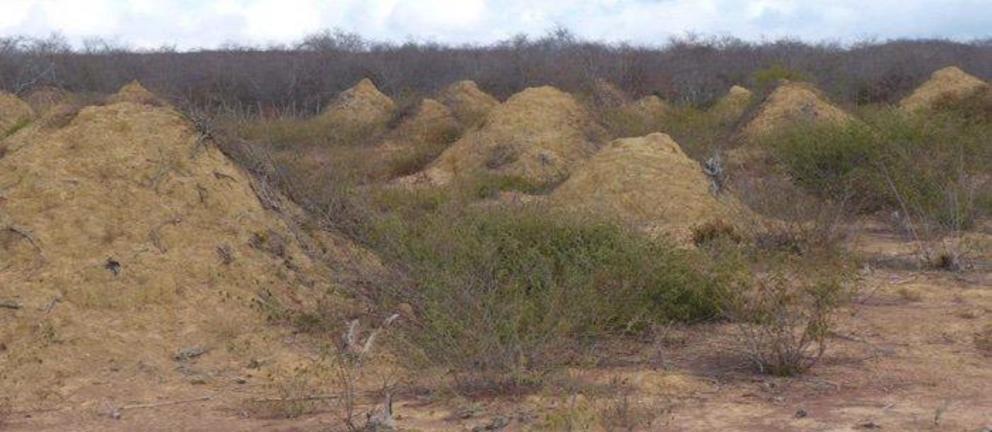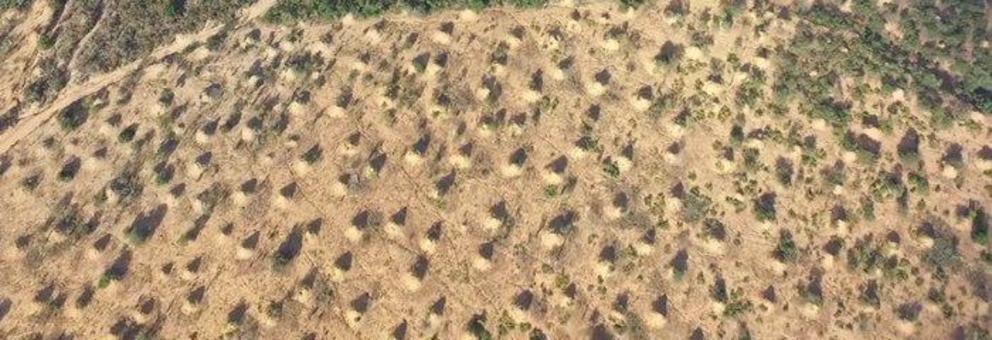These mysterious mounds in Brazil are 4,000 years old and visible from space
One of the largest and strangest engineered structures on Earth is almost completely hidden from the world, unless you know where to look.
Buried in the Caatinga vegetation of northeastern Brazil, scientists have uncovered the true scale of a vast array of some 200 million termite mounds covering an area the size of Great Britain.
What's amazing about this huge complex of dispersed dirt – aside from its sheer volume, estimated at 10 cubic kilometres (2.4 cubic miles) of soil – is how few people actually seem to know about it.
Biologist Roy Funch from Brazil's Universidade Estadual de Feira de Santana first noticed the mysterious mounds in the early 1980s, which had rarely if ever been encountered by 'outsiders' before land clearing revealed the strange stacks in recent decades.

(Martin et al)
"Some locals thought they were formed by termites or ants or some such creature," Funch told ScienceAlert.
"But for many, they were just there – natural, God-made formations that had always existed – for the hardscrabble dry-land region of cattle raising and small-plot farming didn't leave much time for speculation."
At the time, Funch wrote about them for a popular science magazine in Brazil, but as the decades passed, no scientists ever reported their existence.
To rectify this oversight, Funch released a paper about the mounds in 2015, but it's only in new research that the full extent of this massive moundtropolis has been laid bare.
In 2015, Funch estimated there were about 90 million mounds, consisting of the volume of about 900 Great Pyramids of Giza of displaced soil, and called the structure "arguably the greatest example of insect biopedoturbation and ecosystem engineering at a landscape scale yet recorded".
 Martin et al.
Martin et al.
(Martin et al., Cell Biology, 2018)
Since then, the estimate has only been revised upward. Funch and fellow researchers' new investigations suggest there's about 200 million mounds representing approximately 4,000 Great Pyramids in volume, and they're about 4,000 years old.
Such a giant footprint means you can easily see the array from space via the wonders of satellite imagery: note the mounds visible in both cleared land and contrasting scrub on Google Earth.
"For scale, the termite mounds occupy an area roughly equivalent to the Great Barrier Reef – a multiple-species bioengineering feat," Funch says, "[whereas] the mounds we report on are built by a single species of termite."
That termite species is Syntermes dirus. But how did these mounds – which stand about 2.5 metres (8.2 ft) tall and reach 9 metres (29.5 ft) across – get there, and how did S. dirus engineer them to be so evenly dispersed throughout the Caatinga landscape?
According to the team, who analysed the structures from the air and on the ground, the 200 million heaps represent the soil displaced from a massive network of subterranean tunnels, which allows the termites to easily reach the surface to access their food source: fallen leaves.
"There is no grand plan. Like flocks of birds, so long as they stay a constant distance from their neighbour, the entire flock of thousands flows in an ordered manner," first author and social entomologist Stephen Martin from the University of Salford in the UK told ScienceAlert.
"It's just that due to the dead leafs (food) falling once a year, you need an efficient system to obtain as much food as possible before it disappears."
Soil samples taken from some of the mounds reveal they were filled between 690 to 3,820 years ago, making them about as old as the world's oldest known termite mounds in Africa.
Yet despite the mounds' remarkable age and size, it seems millennia of termite toil, digging, and leaf foraging has basically been completely ignored by humans who didn't notice it because of the obfuscating Caatinga scrub.
Unless you're a curious and determined scientist, that is, with handy access to an eye in the sky.
"The scale is beyond belief," Martin says. "People don't believe the scale, it's so big … it's truly mind-bending."
The findings are reported in Cell Biology.
